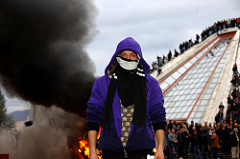clear
How can public unrest change the situation in Macedonia?
clear

source:
godo godaj / Flickr
Macedonia has a history of political tension and instability, and narrowly escaped all-out civil war in 2001.
Zoran Zaev, the head of the opposition Social Democrats, wore a white adhesive bandage over a gash on his forehead as he accused his attackers of attempted murder with the parliament invasion. Former Prime Minister Nikola Gruevski, whose supporters were among the mob that burst into the building on Thursday, said he deplored the violence, but accused his political rivals of instigating it with an attempted power grab.
The U.S. Embassy in Macedonia's capital condemned the violence "in the strongest terms," and said it would work with Xhaferi "to support democracy and to advance the interests of Macedonia." A State Department comment released later Friday took similar lines.
The country was wracked by unrest in the early 2000s following an armed insurrection by ethnic Albanians, who make up about a quarter of the population.
A peace agreement, brokered by NATO, ended with the government agreeing to provide more rights to the minority and ethnic Albanians saying they will abandon their goal of a separate state. But tensions have lingered since then. Macedonia hasn’t had a functioning government since 2015 when the government led by the nationalists of the VMRO-DPMNE were brought down by a wiretapping scandal.
 0
0
clear
 Wafa Benizid
6 years, 11 months ago
Wafa Benizid
6 years, 11 months ago